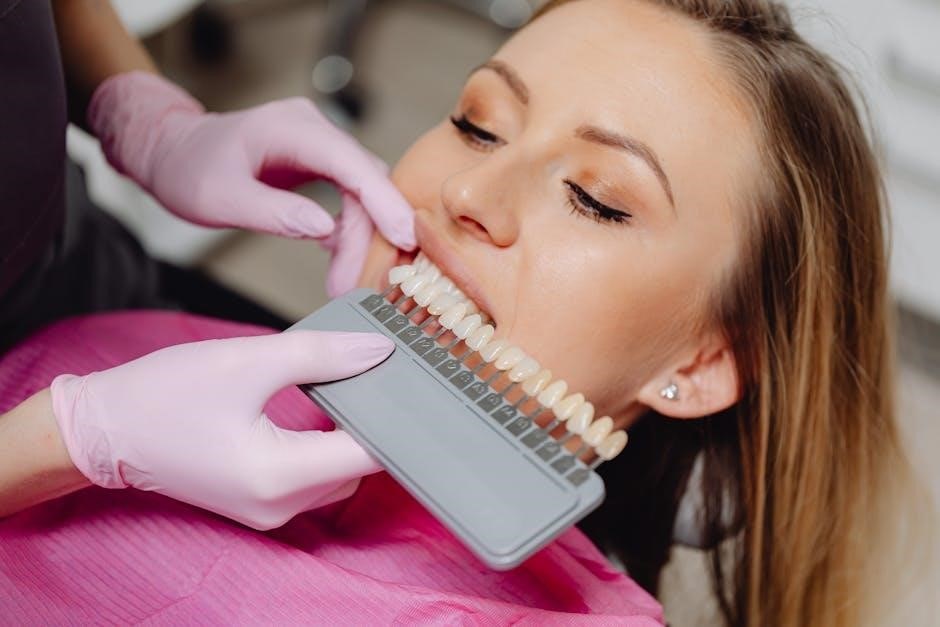Promoting Healthy Smiles: A Parent’s Guide to Children’s Teeth
Promoting healthy smiles in children begins with early dental care. Start brushing and flossing regularly, use fluoride toothpaste, and ensure a balanced diet. Regular dental visits are essential for maintaining strong, cavity-free teeth and overall oral health.
1.1 Importance of Early Dental Care
Early dental care is crucial for preventing tooth decay and promoting lifelong oral health. Start cleaning your baby’s gums before the first tooth appears, using a damp cloth. Once teeth erupt, brush gently with fluoride toothpaste. Regular care helps prevent cavities and sets the foundation for healthy habits. Neglecting early dental care can lead to severe issues, making parental involvement essential from the beginning.
1.2 Role of Parents in Maintaining Oral Hygiene
Parents play a vital role in establishing and maintaining their child’s oral hygiene. Supervising brushing sessions, teaching proper techniques, and limiting sugary foods are essential. Encourage a consistent routine, such as brushing twice daily, and lead by example to make oral care a family affair. Parents should also monitor fluoride intake and ensure regular dental check-ups to foster healthy habits and prevent future issues.
Understanding Tooth Development and Eruption Timelines
Understanding tooth development and eruption timelines helps parents anticipate milestones. Teething begins around six months, starting with front teeth, followed by molars and canines. Timeline may vary.

2.1 Tooth Eruption Schedule: What to Expect
Teething typically begins around 4-7 months with front teeth (incisors) appearing first. Molars emerge next, followed by canines. Most children have a full set of 20 primary teeth by age 3. Eruption timelines vary, but parents should monitor progress and consult a dentist if significant delays occur. Understanding this schedule helps prepare for milestones and address any concerns early.
2.2 Factors Affecting Teething and Tooth Development
Genetics, nutrition, and overall health significantly influence teething and tooth development. A balanced diet rich in calcium and vitamins supports healthy growth. Premature birth or medical conditions can delay eruption. Environmental factors, like fluoride exposure, also play a role. Monitoring your child’s progress and consulting a dentist if deviations occur ensures timely intervention and optimal oral health outcomes.

Oral Hygiene Habits for Kids
Establishing a consistent oral hygiene routine is crucial. Encourage brushing twice daily with fluoride toothpaste and flossing to remove plaque. Supervise young children to ensure proper technique and build lifelong healthy habits.
3.1 When to Start Brushing and How to Do It Right
Start brushing as soon as the first tooth appears, around six months old. Use a soft-bristle toothbrush and a smear of fluoride toothpaste. Gently brush all surfaces, focusing on areas where teeth and gums meet. For children under three, use a smear or grain-of-rice-sized amount. Supervise to ensure proper technique and avoid swallowing toothpaste. Early brushing helps prevent cavities and establishes a lifelong oral hygiene routine.
3.2 Brushing Techniques and Choosing the Right Toothbrush
Choose a toothbrush with soft bristles and a small head for easy access to all teeth. Select a child-sized brush for little hands. Use gentle circular motions, focusing on the gum line. Replace the toothbrush every three months or when bristles fray. Pair with fluoride toothpaste for effective cleaning. Demonstrate proper brushing technique to ensure thorough cleaning, especially in the morning and before bed.

3.3 The Basics of Flossing for Children
Introduce flossing to children around 2-3 years old to remove plaque between teeth. Use kid-friendly flossers or floss picks for easy handling. Gently guide the floss between teeth in a curved motion, avoiding gum irritation. Demonstrate proper technique and make it a daily habit, ideally before bed. Consistency helps prevent cavities and promotes healthy gums, laying the foundation for a lifelong oral hygiene routine.

The Role of Diet and Nutrition in Teeth Health
A healthy diet rich in fruits, vegetables, and whole grains supports strong teeth. Limit sugary snacks and drinks to prevent decay, promoting a balanced intake for optimal oral health.
4.1 Limiting Sugary Snacks and Drinks
Limiting sugary snacks and drinks is crucial for protecting children’s teeth. Sugary treats feed harmful bacteria, leading to acid production and tooth decay. Encourage water or milk instead of sugary beverages. Offer fruits, vegetables, and whole grains as healthier alternatives. Avoid frequent snacking and set a good example by limiting sugary treats yourself; Teach children to rinse their mouths with water after consuming sugary foods to reduce damage.

4.2 Encouraging Healthy Food Choices for Strong Teeth
Encourage healthy food choices to support strong teeth and overall health. Offer calcium-rich foods like milk, cheese, and leafy greens to strengthen enamel. Include vitamin and mineral-rich options such as fruits, vegetables, and whole grains. Limit starchy snacks and sugary treats that can harm teeth. Teach children to make nutritious choices by leading by example and making mealtime engaging. A balanced diet fosters healthy teeth and gums for life.
First Dental Visits and Check-Ups
Regular dental visits are crucial for early detection of oral issues. Schedule your child’s first visit by their first tooth or sixth month. A check-up ensures healthy development and addresses concerns early, fostering a lifetime of good oral health habits.
5.1 When to Schedule Your Child’s First Dental Visit
The first dental visit should occur when the first tooth appears or by the child’s sixth month. Early check-ups help prevent issues and familiarize your child with dental care. Even before the first tooth, gums should be gently cleaned with a damp cloth. Schedule regular visits every six months to monitor development and ensure a healthy smile from the start.
5.2 What to Expect During the First Dental Check-Up
The first dental visit involves a gentle examination of your child’s mouth to check for proper tooth development and any signs of issues. The dentist will discuss oral hygiene practices, such as brushing techniques, and provide guidance on diet and fluoride use. This visit is also an opportunity to address concerns and establish a positive relationship with dental care, ensuring a strong foundation for future oral health.
The Importance of Fluoride for Teeth
Fluoride strengthens tooth enamel, preventing decay and promoting healthy smiles. It’s essential for children’s teeth, available in toothpaste and water, and supported by dental professionals for lifelong protection.
6.1 Why Fluoride is Essential for Healthy Teeth
Fluoride is crucial for strengthening tooth enamel, preventing decay, and making teeth more resistant to acid attacks from sugars. It helps reverse early stages of tooth decay, promoting healthier smiles. Dental professionals recommend fluoride toothpaste and treatments for children, as it supports the development of strong, cavity-resistant teeth from an early age, ensuring long-term oral health benefits and preventing future dental issues.
6.2 How to Use Fluoride Toothpaste Correctly
Use fluoride toothpaste twice daily for optimal results. For children, apply a pea-sized amount, ensuring they spit it out to avoid swallowing. Parents should supervise brushing to prevent overuse. Choose a toothpaste with the ADA Seal of Acceptance and a soft-bristle toothbrush. Start fluoride toothpaste when the first tooth appears, typically around six months old, to promote strong, healthy teeth and prevent cavities effectively.
Teething: Signs, Symptoms, and Soothing Tips
Teething begins around 4-7 months, causing drooling and irritability. Soothe your baby with cold teething rings or a damp washcloth. Gently massage gums for relief.
7.1 Recognizing the Signs of Teething
Teething typically begins around 4-7 months. Signs include drooling, irritability, chewing on objects, and swollen gums. Some babies may experience mild fever or loss of appetite. Monitor your baby’s behavior and look for these indicators to identify teething. Not all babies show the same symptoms, so be observant to determine if teething is the cause of discomfort.
7.2 How to Soothe a Teething Baby
To soothe a teething baby, offer cold objects like teething rings or a chilled washcloth to chew on. Gently massage their gums with your finger. Over-the-counter teething gels can help, but always consult a dentist first. Ensure the baby stays comfortable and distracted with toys or cuddles. Avoid hard objects that could harm their gums. Monitor their discomfort and adapt your approach as needed for relief.

Common Dental Issues in Children
Common dental issues in children include cavities, tooth decay, and thumb sucking. Overcrowding and sensitivity are also prevalent. Regular check-ups help prevent these problems.
8.1 Understanding and Preventing Cavities
Cavities are among the most common dental issues in children, caused by bacteria and poor oral hygiene. They occur when acids from sugary foods erode tooth enamel. Prevention involves regular brushing with fluoride toothpaste, limiting sugary snacks, and promoting good oral hygiene habits. Early detection and treatment are crucial to prevent further damage. Dental sealants and fluoride treatments can also help protect teeth from decay.
8.2 Dealing with Thumb Sucking and Its Impact on Teeth
Thumb sucking is a common habit in children that can affect tooth alignment. Prolonged sucking, especially after the age of two, may lead to an overbite or misaligned teeth. Parents should monitor the habit and encourage breaking it by age three. Pacifiers can have similar effects. If concerns arise, consult a dentist for guidance on correcting alignment issues or preventing further damage to your child’s teeth.
Special Needs and Oral Care

Children with special needs require tailored oral care to ensure their dental health. Parents should adapt routines to meet individual needs and work closely with dentists.
9.1 Dental Care for Children with Special Needs
Children with special needs require customized dental care. Parents should adapt oral hygiene routines to their child’s abilities and sensory sensitivities. Communicate with dentists to create a comfortable environment and address unique challenges. Regular check-ups are crucial for early detection of issues; Use visual aids or desensitization techniques to ease anxiety, ensuring a positive experience that supports long-term oral health and well-being.
9.2 Working with Dentists to Address Special Needs
Collaborating with dentists is key to addressing special needs. Parents should communicate their child’s specific requirements and any sensitivities. Dentists can create personalized care plans, including adaptive tools or techniques. Regular follow-ups ensure tailored solutions are effective. Building trust and open communication fosters a supportive environment, enabling children with special needs to receive optimal oral care and maintain their dental health successfully.

Establishing a Lifelong Oral Hygiene Routine
Encourage consistent brushing and flossing to create a routine. Make it a family affair to show its importance. This builds a strong foundation for lifelong habits and healthy smiles.
10.1 Tips for Making Brushing a Family Affair
Make brushing a fun, bonding experience by doing it together. Choose toothbrushes and toothpaste as a team, and play music to create a positive atmosphere. Praise your child’s efforts to encourage consistency. Lead by example and explain the importance of oral hygiene. Supervise and guide them to ensure proper technique. Establishing this routine fosters a lifelong habit and strengthens your connection with your child.

10.2 Educating Your Child About the Importance of Oral Health
Teach your child why oral health matters by explaining how teeth help us eat, speak, and smile. Use simple, age-appropriate language to describe how brushing and flossing remove harmful plaque. Make it engaging by showing pictures or videos of healthy teeth. Encourage questions and involve them in choosing toothbrushes or toothpaste. Praise their efforts to create a positive association with oral care, fostering a lifelong commitment to healthy habits.